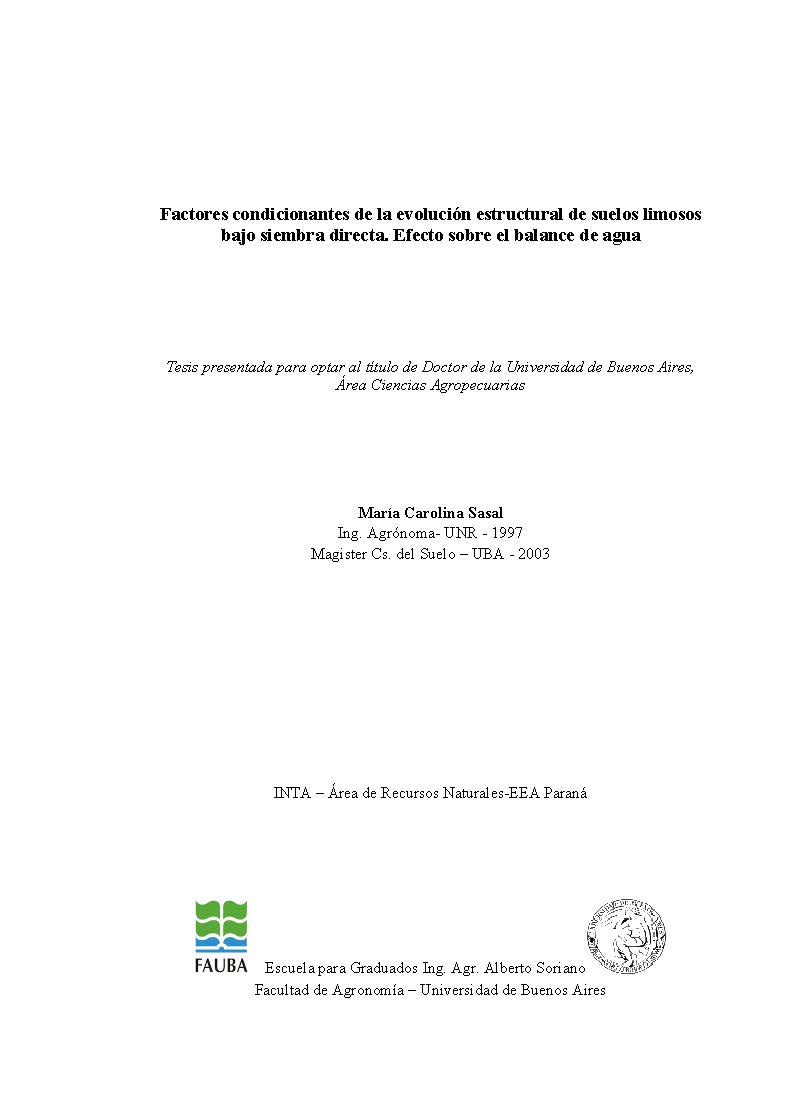View Item
- xmlui.general.dspace_homeCentros Regionales y EEAsCentro Regional Entre RíosEEA ParanáTesisxmlui.ArtifactBrowser.ItemViewer.trail
Factores condicionantes de la evolución estructural de suelos limosos bajo siembra directa. Efecto sobre el balance de agua
Abstract
La evolución estructural de los suelos y su relación con la dinámica del agua son
aspectos clave en la sustentabilidad de los agro-ecosistemas. La siembra directa (SD)
combinada con la simplificación de secuencias de cultivos, generan la necesidad de
estudiar nuevos aspectos de la degradación física de suelos cultivados. El objetivo de
esta tesis fue identificar factores condicionantes de la evolución estructural de suelos
limosos bajo SD y analizar
[ver mas...]
La evolución estructural de los suelos y su relación con la dinámica del agua son
aspectos clave en la sustentabilidad de los agro-ecosistemas. La siembra directa (SD)
combinada con la simplificación de secuencias de cultivos, generan la necesidad de
estudiar nuevos aspectos de la degradación física de suelos cultivados. El objetivo de
esta tesis fue identificar factores condicionantes de la evolución estructural de suelos
limosos bajo SD y analizar las consecuencias de la presencia de estructura laminar y
otras estructuras asociadas sobre el balance de agua. Se aplicó el método del perfil
cultural en distintos sitios de la Pampa Húmeda norte y se realizaron ensayos de campo
(tránsito, cobertura, secuencias) y laboratorio (humedecimiento-secado, intervalo
hídrico óptimo) para modelar la evolución de la estructura laminar, identificar sus
factores formadores y cuantificar su efecto sobre el funcionamiento hídrico. El
desarrollo de estructura laminar está generalizado en la Pampa Húmeda norte. Su
proporción en el perfil está asociada con el número de años bajo SD. El tránsito agrícola
y la cobertura superficial no afectaron su evolución. La estructura laminar se forma por
fisuración por humedecimiento-secado de una estructura masiva subyacente. La
distribución de macroporos de esta estructura y su estabilidad, afectan la
microfisuración y la formación de agregados elongados. Las raíces contribuyen con el
crecimiento lateral y la exploración de la capa superficial del suelo por impedimento en
su profundización cuando la densidad aparente es crítica (>1,44 Mg m-3). La estructura
laminar altera el patrón de drenaje y aumenta el escurrimiento superficial en función de
su proporción en el perfil del horizonte A. La secuencia de cultivos implementada bajo
SD condiciona su formación y en consecuencia el funcionamiento hídrico del suelo. Las
ecuaciones generadas permitirán identificar secuencias de cultivos que mejoren la
captación de agua para aumentar rendimientos y minimizar riesgos ambientales.
[Cerrar]
The structural evolution of soils and its relation to the dynamics of water are key issues
in the sustainability of agro-ecosystems. No tillage (NT), together with the
simplification of crop sequences, has generated the need to explore new aspects of the
physical degradation of cultivated soils. The aim of this thesis was to identify
determinants of the structural evolution of silty soils under NT and analyze the
consequences of the presence of platy
[ver mas...]
The structural evolution of soils and its relation to the dynamics of water are key issues
in the sustainability of agro-ecosystems. No tillage (NT), together with the
simplification of crop sequences, has generated the need to explore new aspects of the
physical degradation of cultivated soils. The aim of this thesis was to identify
determinants of the structural evolution of silty soils under NT and analyze the
consequences of the presence of platy structure and other associated structures on the
water balance. To this end, we applied the method of the cultural profile in different
sites of the northern Humid Pampas and conducted experiments both in the field
(machinery transit, coverage, crop sequences) and the laboratory (wetting-drying, least
limited water range) to model the evolution of platy structure, identify its forming
factors, and quantify their effect on the water functioning. The development of platy
structure is widespread in the northern Humid Pampas. Its proportion in the topsoil
profile is associated with the number of years under NT. Neither the machinery transit
nor the surface coverage affected its evolution. The platy structure is formed by wettingdrying
cracking of the massive structure underneath. The distribution of macropores of
this structure and its stability affect the micro-cracking and the formation of elongated
aggregates. The roots contribute with their lateral growth and the exploration of the
topsoil since they cannot go further deep when the bulk density is critical (>1.44 Mg m-
3). The platy structure alters the drainage pattern and increases the surface runoff
according to its proportion in the profile of A horizon. The crop sequence implemented
under NT affects its formation and, consequently, the soil water dynamics. The
equations generated will allow identifying the crop sequences that allow improving the
uptake of water to increase yields and minimize environmental risks.
[Cerrar]

Author
Director de Tesis
Descripción
Tesis para obtener el grado de Doctor Área Ciencias Agropecuarias, presentada en la Facultad de Agronomía, Universidad de Buenos Aires en marzo de 2012
Date
2012-03
Editorial
Escuela para Graduados Ing. Agr. Alberto Soriano, Facultad de Agronomía, Universidad de Buenos Aires
Formato
pdf
Tipo de documento
tesis doctoral
Palabras Claves
Derechos de acceso
Abierto
 Excepto donde se diga explicitamente, este item se publica bajo la siguiente descripción: Creative Commons Attribution-NonCommercial-ShareAlike 2.5 Unported (CC BY-NC-SA 2.5)
Excepto donde se diga explicitamente, este item se publica bajo la siguiente descripción: Creative Commons Attribution-NonCommercial-ShareAlike 2.5 Unported (CC BY-NC-SA 2.5)


